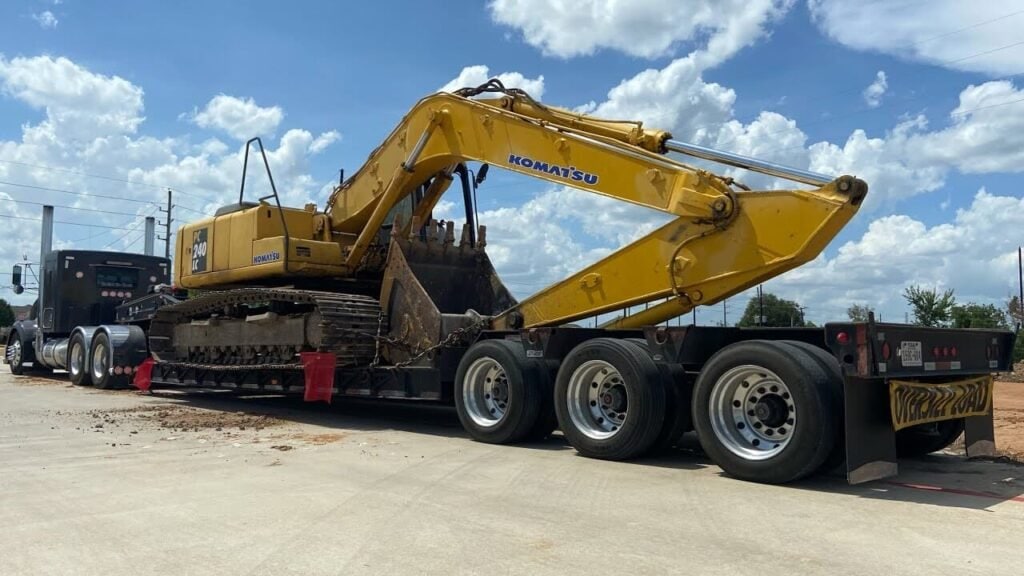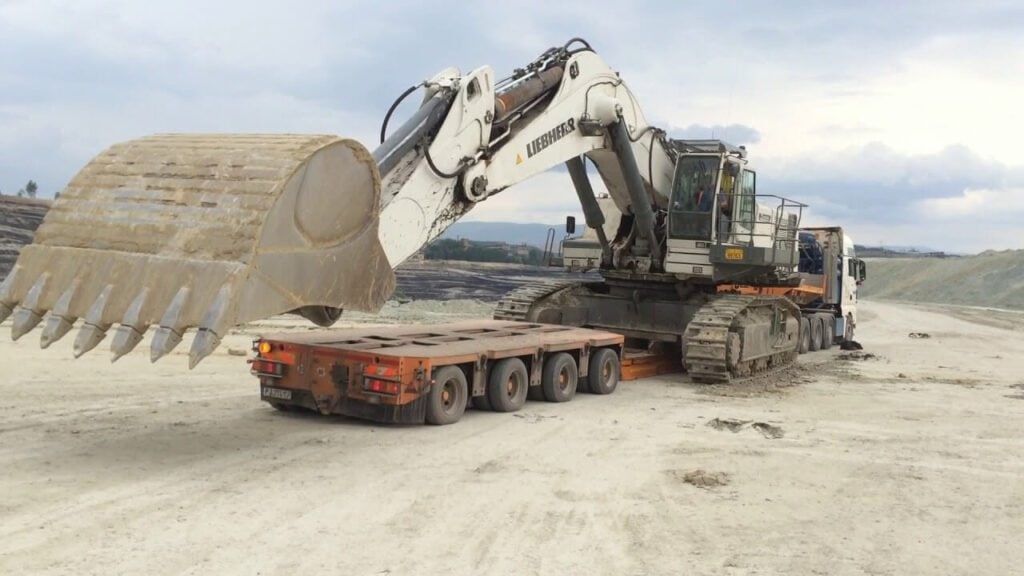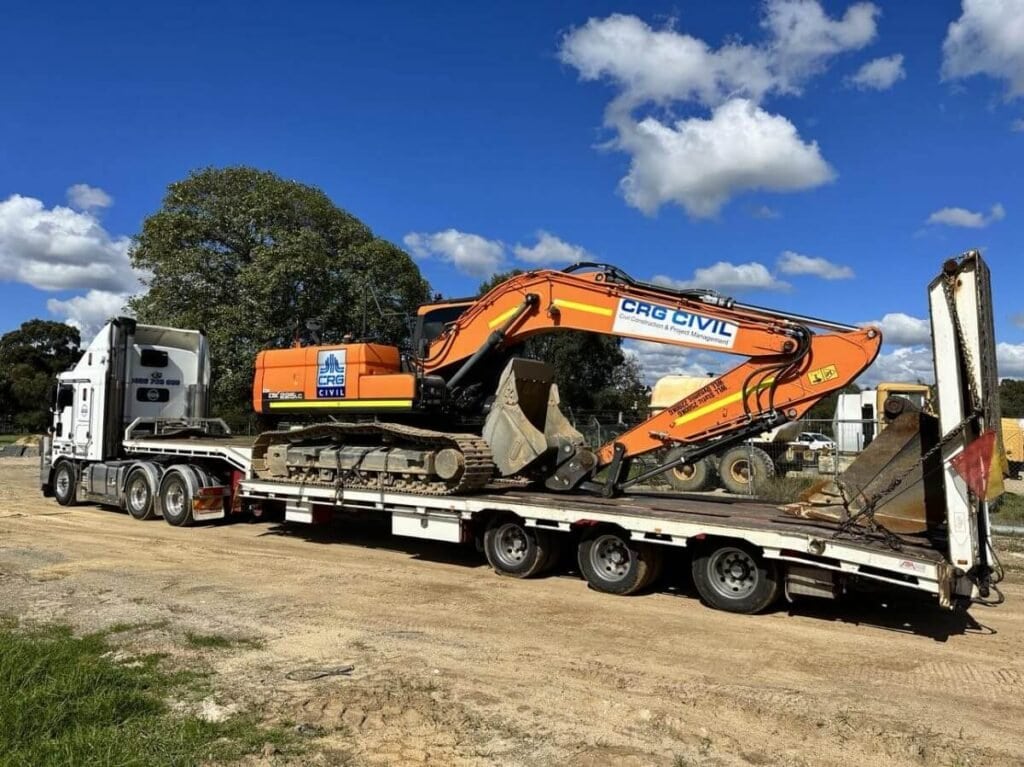Transporting an excavator, whether it’s to a construction site or between locations, requires meticulous planning and execution. Given the size, weight, and complexity of these heavy machines, using the best methods to transport them safely is critical not only to protect the equipment but also to avoid damage to roads, other vehicles, and to ensure safety during transport.
In this article, we’ll explore the best methods for transporting excavators safely, including key considerations, necessary equipment, and important safety precautions.

1 et 1 Use of Proper Trailers and Transport Vehicles
One of the most crucial steps in transporting an excavator safely is selecting the correct trailer and transport vehicle.
What to Consider:
- Trailer Type: Lowboy and flatbed trailers are commonly used for transporting excavators. A lowboy trailer is ideal for heavy machines because it offers a lower deck height, reducing the risk of damage and making loading and unloading easier.
- Weight Capacity: Ensure the trailer can handle the weight of the excavator. Excavators can range from a few tons to over 70 tons, so the vehicle and trailer must be rated for the specific weight of your machine.
- Compatibilité de taille: Confirm that the excavator will fit on the trailer, both in terms of length, width, and height. Some excavators may need customized trailers with wider or longer beds.
By ensuring the trailer is compatible with your excavator’s dimensions and weight, you can prevent accidents caused by overloading or instability during transit.
2 Loading and Unloading Procedures
Safe Loading Excavator:
- Use a Loading Ramp or Hydraulic Lift: Loading an excavator onto a trailer requires either a ramp or hydraulic lift to raise the machine. Always ensure the loading area is flat and stable.
- Proper Loading Sequence: For larger excavators, it’s essential to load the machine head-first to prevent overloading the rear of the trailer and ensure the weight is distributed evenly.
Safe Unloading Excavator:
- Gradual Unloading: When unloading, use the reverse procedure of loading, ensuring that the excavator moves slowly off the trailer. Sudden movements can cause instability and may damage the machine or the transport vehicle.
Always ensure that the trailer and equipment are positioned on stable, level ground before starting the unloading process.

3 et 3 Securing the Excavator During Transit
The key to preventing damage during transporting excavators is securely fastening the excavator to the trailer.
Securing the Excavator:
- Tie-Downs and Straps: Heavy-duty ratchet straps or chains should be used to fasten the excavator to the trailer. Attach straps to the lifting points on the excavator, ensuring the machine is secured at multiple points.
- Wheel Chocks: Placing wheel chocks on the front and rear of the excavator’s tracks or tires will prevent movement while in transit.
- Use of Stabilizers: Some trailers come with built-in stabilizers or brackets that can further secure the excavator, ensuring it remains stationary during transport.
Proper securing prevents the excavator from shifting or tipping, both of which can cause damage to the machine and pose a safety risk.

4 Route Planning and Logistics
Transporting heavy equipment like an excavator is not as simple as driving it to the destination. Planning the route is essential to ensure a smooth, efficient, and safe journey.
Things to Consider:
- Height and Width Clearances: Ensure the route has adequate clearance for the excavator’s height and width. Some roads may have low bridges or narrow lanes that could cause the excavator to get stuck or damaged.
- Road Conditions: Heavy machines can damage roads or suffer damage themselves on rough terrain. Plan a route with smooth, paved roads, and avoid routes with sharp curves or steep inclines.
- Permits and Regulations: Transporting an excavator may require specific permits, especially if the machine is oversized. Make sure all the necessary legal paperwork is in place before transporting the machine.
Route planning will help avoid unexpected delays, accidents, or complications during transport.
5 Escort and Flagging for Oversized Loads
If the excavator is oversized (exceeding legal width or weight limits), it may require an escort vehicle to ensure the safety of other road users.
Oversized Load Requirements:
- Escort Vehicles: These vehicles will travel ahead of or behind the excavator to warn other drivers of the oversized load, direct traffic, and clear any obstacles.
- Flagging: Additionally, flaggers may be required to help manage traffic around the excavator, particularly when traveling through busy areas or highways.
Using an escort vehicle and flagging can prevent accidents and delays caused by confusion around the oversized load.

6. Monitoring and Adjusting During Transit
Once the excavator is on the move, ongoing monitoring is vital.
Monitoring:
- Check Securement Regularly: During the transport process, periodically stop and check the straps, chains, and any other securing devices to ensure that the excavator remains firmly in place.
- Assess the Transport Vehicle: Check the condition of the transport vehicle and trailer regularly, particularly if you are traveling long distances. Look out for tire pressure, hitch stability, and potential wear on the equipment.
Monitoring during transit ensures the excavator remains secure and any minor issues can be addressed before they become major problems.
7 Using Professional Transport Services
If you are unsure about how to handle the transport of heavy machinery like excavators, it may be beneficial to hire a professional transport company.
Benefits of Professional Transport Services:
- Connaissances d'experts: Professionals are experienced in handling heavy equipment, from loading and securing to transporting and unloading. They understand the regulations and can ensure that all safety protocols are followed.
- Specialized Equipment: These companies often have specialized trailers, lifts, and securing mechanisms designed specifically for heavy machinery.
- Insurance Coverage: Hiring professionals also provides insurance coverage in case of any accidents or damage during the transport.
Using a professional service can give you peace of mind, knowing that your excavator is being transported by trained experts.

Conclusion
Transporting an excavator safely involves careful planning and execution at each step. From selecting the right trailer and securing the machine to monitoring during transit, following these best practices will ensure that your excavator reaches its destination without issues. Whether you’re handling the transport yourself or hiring a professional service, prioritizing safety and efficiency will help avoid unnecessary damage, downtime, and costs.